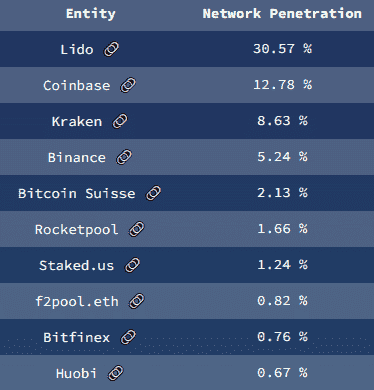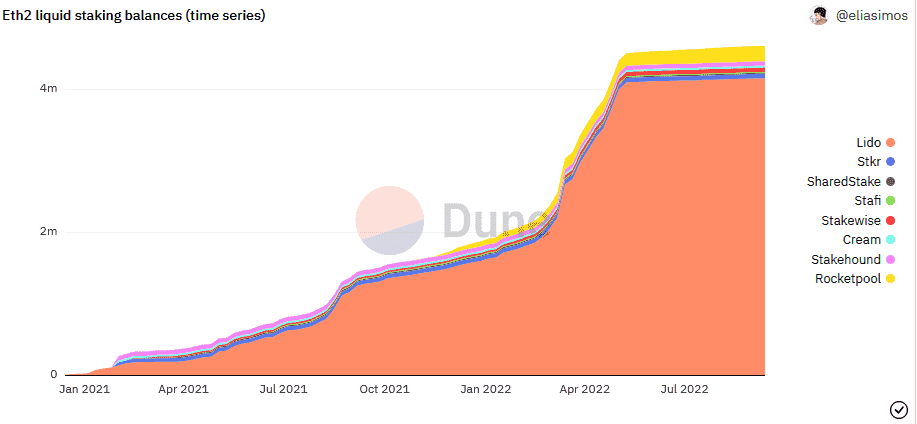The crypto community is concerned that the Ethereum blockchain will be less decentralized after the merge than before. She worries that moving to Proof of Stake (PoS) will make the network less censorship-resistant as a few large staking providers will control the majority of staking tokens.
This concern is not unfounded. Currently, the four largest staking providers own around 60 percent of all ETH staked. Almost 31 percent of this is currently with the DeFi protocol Lido (LDO).
read too

Another 26.65 percent can be assigned to the three centralized exchanges Binance (5.24%), Coinbase (12.78%) and Kraken (8.63%). At the moment, centralized exchanges may not have a 51 percent share of the network, but as their staking holdings continue to grow, the risk of a 51 percent attack, such as exchange collusion, becomes a reality.
In plain language, this means that crypto exchanges could join forces, either voluntarily or by force, to censor transactions within the Ethereum network.
The same is also true for liquid staking protocols like Lido (30.57%) or Rocket Pool (1.66%). Such DeFi protocols usually have a much more decentralized structure than Binance and Co., but can still be dangerous for the Ethereum Blockchain if there is too much staking power. You can find out what exactly is behind Liquid Ethereum Staking here.
For these reasons, the question arises for the Ethereum community: How can the decentralization of the second largest blockchain project by market capitalization be guaranteed in the long term? There are two possibilities.
That can be done for the decentralization of ETH
1. Stake Ethereum yourself
On the one hand, more members of the Ethereum community could become active and run staking validators themselves.
The basic requirement for this is 32 ETH (51,322 US dollars). These are required so that the ETH PoS Validator software can run on a computer that must be permanently online. When choosing the node software, you can choose between several providers.
The best known are currently Prysm Client from Prysmatic Labs, Nimbus, Teku and Lighthouse. You can then follow the instructions on the official Ethereum 2.0 site follow and check out the numerous staking guides YouTube look at. In addition, there are already companies that prebuilt staking nodes offer, the setup process of which is comparatively simple.
Still, the whole process requires some technical knowledge and certain Hardware Requirements. In addition, 32 ETH, which is currently worth over $50,000, is affordable for very few investors.
Therefore, even staking is unlikely to be the long-term solution to ensure the decentralization of the Ethereum network. Still, each ETH staking validator contributes more to Ethereum becoming more decentralized.
2. Staking ETH with liquid staking protocols
On the other hand, you can stake your ether with so-called liquid staking protocols (Lido, Rocket Pool, etc.). The big advantage is that investors, similar to centralized exchanges, do not need 32 ETH to operate staking.
All they have to do is deposit ETH into a liquid staking protocol that stakes on their behalf, and in return they receive a liquid staking token that automatically accumulates staking rewards, is tradable, and gives them 1:1 entitlement to their staking tokens .
In return, however, they give up self-management of their staked ETH and a portion of their staking returns go to the liquid staking protocol. For example, investors pay into Lido ETH or buy stETH (staked Lido ETH) on an exchange to participate in Ethereum staking.
Major liquid staking protocols include Lido, Ankrstakehound and Rocket Pool, with Lido with stETH currently by far the largest liquid staking protocol – over 90 percent market share.

The biggest risk posed to Ethereum’s decentralization by liquid staking protocols is that they are responsible for delegating the tokens to validators.
Therefore, as a single liquid staking protocol grows larger, so does its underlying proof-of-stake blockchain. Liquid staking projects like Lido are working on it to further decentralize their protocols, but come across often to their limits, as further decentralization comes at the expense of their profitability. This conflict of interest keeps LDO holders from self-interest in the past against further decentralization of the protocol voted.
Other liquid staking protocols, such as Rocket Pool, have therefore made it their top priority to ensure the decentralization of their protocol. You can read here whether and how exactly this should succeed.
Conclusion
Ultimately, it is in the hands of every ETH owner to ensure the decentralization of Ethereum. Everyone is free to stake their ethers themselves or through a staking provider.
It is therefore important that especially those who are not yet staking their ETH themselves know who they can stake their ether with. What interests does the provider pursue? Does he advocate for Ethereum’s decentralization? Is it already too powerful, so isn’t it better to choose a smaller one?
If you want to support the decentralization of the Ethereum network on the one hand and benefit from it in the long term on the other, you should ask yourself these questions before blindly choosing a staking provider.
Do you want to buy cryptocurrencies?
Trade the most popular cryptocurrencies like Bitcoin and Ethereum with leverage on Plus500, the leading CFD trading platform (77 percent of retail accounts lose money with the provider).
